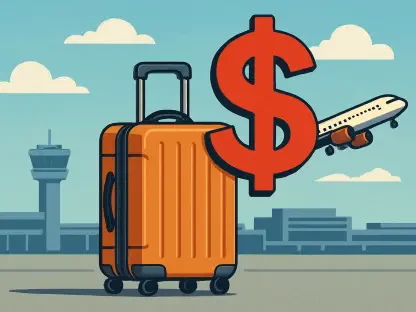What if a small fee added to a hotel bill could either save or sink the UK’s struggling tourism industry, especially in cities like Edinburgh, Manchester, and Liverpool where overnight visitor levies—charges added to each night’s stay—are sparking heated debates? These fees promise to fund local economies, but at what cost to an industry still recovering from global challenges? High Streets UK, a coalition representing over 5,000 businesses, is stepping into the fray, demanding a voice in how these policies unfold. This isn’t just about extra charges; it’s about shaping the future of tourism in a way that balances revenue with recovery.
The importance of this issue cannot be overstated. Tourism pumps £31 billion directly into the UK economy through overnight stays, supporting 2.5 million jobs, according to the Tourism Alliance. With visitor levies rolling out or under consideration in multiple cities, the stakes are high for businesses that rely on both domestic and international travelers. High Streets UK warns that without careful collaboration, these fees risk deterring visitors and stalling an already fragile recovery. This story dives into the heart of the controversy, exploring why business input is critical to getting it right.
Why Visitor Levies Are Fueling Controversy in the UK
At the core of this growing storm is a simple question: should tourists foot the bill to bolster local communities? Visitor levies, often a small per-night charge on hotel stays, are pitched as a way to fund high street regeneration and infrastructure. Cities like Edinburgh have already implemented them, while others, including Aberdeen and Manchester, are considering similar moves. Yet, the concept has sharply divided opinions, with mounting concerns over whether the added cost might push travelers to tighten their budgets or choose other destinations.
The debate isn’t just about money—it’s about control and impact. High Streets UK, a powerful voice for businesses in nine major cities, argues that without proper oversight, these levies could harm tourism more than help it. The group points to the risk of alienating domestic travelers, who make up a significant portion of the market, especially as the industry fights to regain its footing. This tension between potential revenue and real-world consequences sets the stage for a broader clash of interests.
The High Stakes of Levies in Today’s Tourism Climate
Tourism remains a lifeline for many UK communities, contributing not just billions in revenue but also sustaining countless livelihoods. However, the sector is still navigating a rocky recovery from past disruptions, making any new financial burden a delicate matter. With visitor levies promising fresh funds for local projects—think revitalized shopping districts or improved public spaces—cities see them as a golden opportunity. Manchester and Liverpool, for instance, are exploring how such charges could reshape their economic landscapes.
Yet, High Streets UK cautions that the timing couldn’t be more challenging. Representing destinations that generate over £50 billion annually, the coalition fears that poorly timed or mismanaged levies might scare off visitors just when they’re needed most. Could a few extra pounds per night tip the scales against a family vacation or a quick city break? This section probes the fine line between harnessing new income and protecting an industry on the mend.
A deeper look reveals that the post-pandemic tourism landscape demands precision. The Tourism Alliance notes that domestic tourism alone fuels £72 billion in indirect economic activity. Any policy that risks dampening this engine must be crafted with extreme care, a point High Streets UK is determined to drive home as cities draft their plans. The challenge lies in ensuring that ambition doesn’t outpace practicality.
Unpacking the Visitor Levy Puzzle: Benefits and Pitfalls
Visitor levies are a complex issue, offering both promise and peril. On one hand, a well-designed levy could inject much-needed cash into local economies—potentially amplifying growth in High Streets UK destinations already worth £50 billion a year. Edinburgh’s recent rollout serves as a test case, with early data suggesting modest revenue gains for public projects. The reward, if managed correctly, could mean more jobs and better infrastructure for residents and visitors alike.
On the flip side, the risks are glaring. High Streets UK highlights that nearly half the public remains unaware that these charges apply to domestic travelers, not just international ones, according to their latest research. This awareness gap could breed resentment if people feel blindsided by unexpected fees. Moreover, if the funds aren’t visibly reinvested into tangible community benefits, support for the levies—already fragile—could collapse entirely.
Public opinion adds another layer of complexity. Surveys by High Streets UK show that support for these charges spikes when revenues are guaranteed to stay local, with 25% of respondents favoring social programs and 23% prioritizing economic boosts like high street renewal. Balancing these competing priorities while avoiding deterring tourists is no small feat. Real-world outcomes in places like Edinburgh will likely shape how other cities approach this contentious policy.
Hearing from the Ground: Business and Community Perspectives
Voices from the frontlines paint a vivid picture of urgency and opportunity. Dee Corsi, chair of High Streets UK, puts it bluntly: “Sustainable tourism is a driver of economic growth, but businesses need a seat at the table to shape levy policies. Ignoring industry input risks real damage.” This sentiment echoed loudly at the group’s recent Tourism Forum in Edinburgh, where an eight-point plan was unveiled to ensure levies are fair, transparent, and locally focused.
Public views carry equal weight in this conversation. Many citizens express willingness to support visitor levies if they see direct benefits in their neighborhoods—think spruced-up town centers or enhanced visitor attractions. This conditional support underscores a critical need: funds must be earmarked for clear, visible reinvestment. Without that assurance, skepticism grows, threatening to undermine the entire initiative.
Bridging these perspectives is no easy task, yet it’s essential. Business leaders stress that collaboration with local authorities can prevent missteps, while community feedback offers a reality check on policy design. Together, these insights form a compelling case for inclusive dialogue, ensuring that levies don’t just raise money but also build trust across the board.
Crafting Tomorrow’s Policies: A Call for Collaboration
High Streets UK isn’t content to merely sound alarms—they’re laying out a path forward for stakeholders to shape visitor levy frameworks. Businesses are encouraged to participate in local consultations, advocating for policies that safeguard tourism while unlocking economic gains. This hands-on approach ensures that the industry’s unique needs, from pricing sensitivities to seasonal trends, aren’t overlooked in the rush for revenue.
Transparency stands as another pillar of reform. Pushing for funds to be earmarked for specific, visible projects—be it small business grants or tourism infrastructure upgrades—can win over both businesses and the public. High Streets UK urges clear reporting on how every penny is spent, turning abstract fees into concrete community wins. This accountability could be the difference between acceptance and opposition.
Finally, closing the knowledge gap is vital. Efforts to educate travelers about who pays these levies and where the money goes can curb misunderstandings and build goodwill. Whether through public campaigns or business-led outreach, clarity matters. Empowering everyone—from hotel owners to everyday citizens—to influence these policies fosters a shared stake in a thriving, sustainable tourism sector.
Looking back, the dialogue around visitor levies revealed a delicate balancing act. High Streets UK led the charge, rallying businesses and communities to demand a voice in policy design, while cities like Edinburgh provided early lessons in both promise and pitfalls. The consensus was clear: local control and transparent reinvestment were non-negotiable for success. Moving forward, the focus shifted to actionable collaboration—ensuring that consultations between stakeholders and policymakers became standard practice. Only through such partnerships could the UK hope to turn a divisive fee into a cornerstone of economic renewal, paving the way for a tourism industry that thrives for all.









